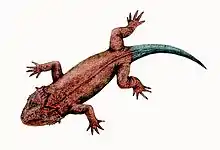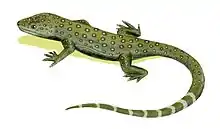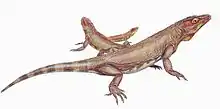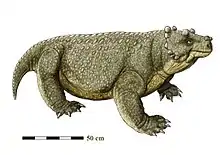Lanthanosuchoidea
Lanthanosuchoidea is an extinct superfamily of ankyramorph parareptiles from the middle Pennsylvanian to the middle Guadalupian epoch (Moscovian[1] - Wordian stages) of Europe, North America and Asia.[2] It was named by the Russian paleontologist Ivachnenko in 1980, and it contains two families Acleistorhinidae and Lanthanosuchidae.[3]
| Lanthanosuchoidea | |
|---|---|
 | |
| Restoration of Lanthanosuchus watsoni | |
| Scientific classification | |
| Kingdom: | Animalia |
| Phylum: | Chordata |
| Class: | Reptilia |
| Clade: | †Parareptilia |
| Order: | †Procolophonomorpha |
| Node: | †Ankyramorpha |
| Superfamily: | †Lanthanosuchoidea Ivachnenko, 1980 |
| Subgroups | |
Phylogeny
Lanthanosuchoidea is a node-based taxon defined in 1997 as "the most recent common ancestor of Lanthanosuchus, Lanthaniscus, and Acleistorhinus".[3] The cladogram below follows the topology from a 2011 analysis by Ruta et al.[2]
| Lanthanosuchoidea |
| ||||||||||||||||||
The cladogram below follows the topology from a 2016 analysis by MacDougall et al.[4]
| Lanthanosuchoidea |
| ||||||||||||||||||||||||||||||
References
- Arjan Mann; Emily J. McDaniel; Emily R. McColville; Hillary C. Maddin (2019). "Carbonodraco lundi gen et sp. nov., the oldest parareptile, from Linton, Ohio, and new insights into the early radiation of reptiles". Royal Society Open Science. 6 (11): Article ID 191191. doi:10.1098/rsos.191191. PMC 6894558. PMID 31827854.
- Marcello Ruta; Juan C. Cisneros; Torsten Liebrect; Linda A. Tsuji; Johannes Muller (2011). "Amniotes through major biological crises: faunal turnover among Parareptiles and the end-Permian mass extinction". Palaeontology. 54 (5): 1117–1137. doi:10.1111/j.1475-4983.2011.01051.x.
- DeBraga, M.; Rieppel, O. (1997). "Reptile phylogeny and the interrelationships of turtles". Zoological Journal of the Linnean Society. 120 (3): 281–354. doi:10.1111/j.1096-3642.1997.tb01280.x.
- MacDougall, M.J.; Modesto, S. P.; Reisz, R. R. (2016). "A new reptile from the Richards Spur Locality, Oklahoma, USA, and patterns of Early Permian parareptile diversification". Journal of Vertebrate Paleontology. 36 (5): e1179641. doi:10.1080/02724634.2016.1179641.
This article is issued from Wikipedia. The text is licensed under Creative Commons - Attribution - Sharealike. Additional terms may apply for the media files.






